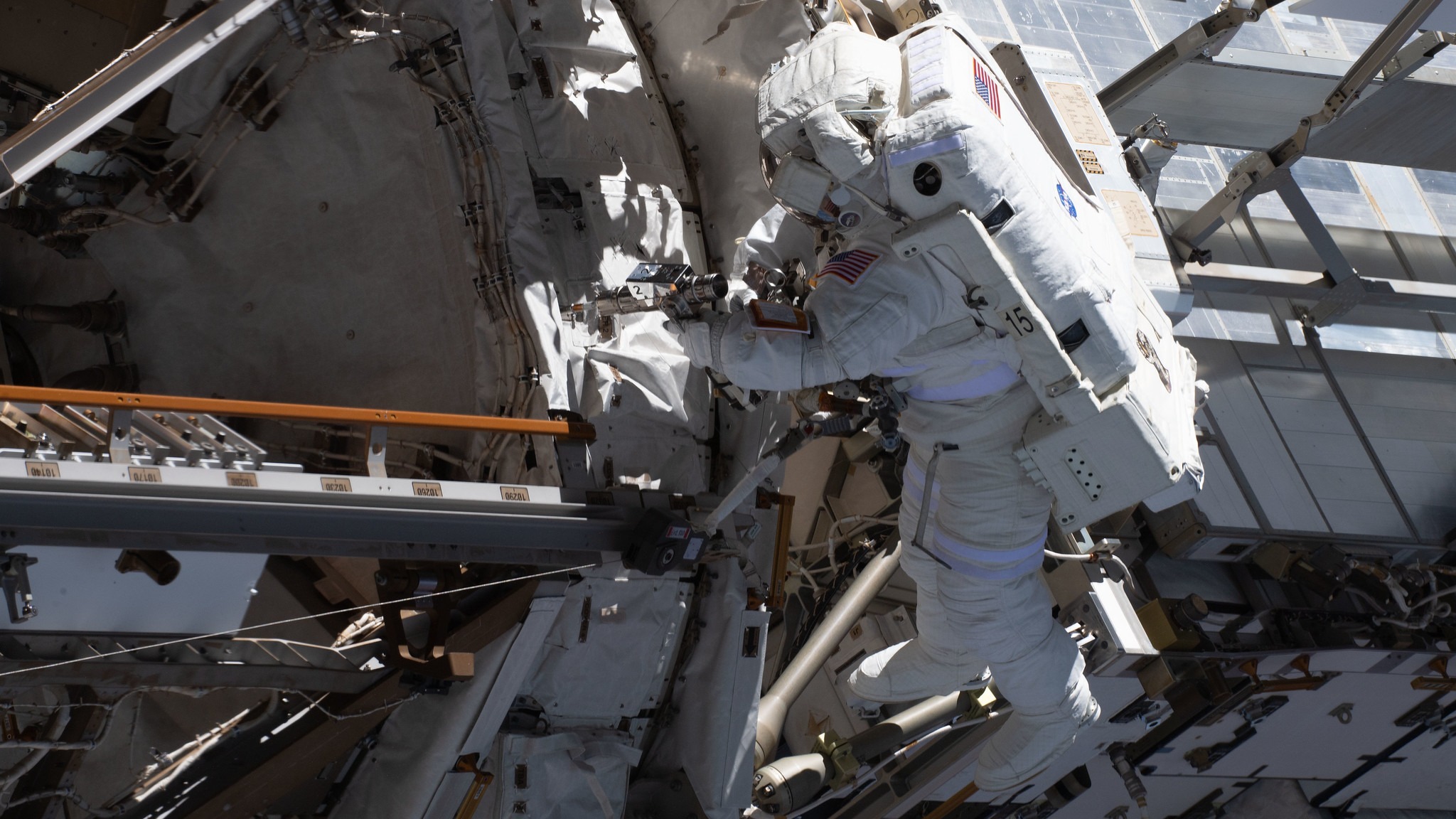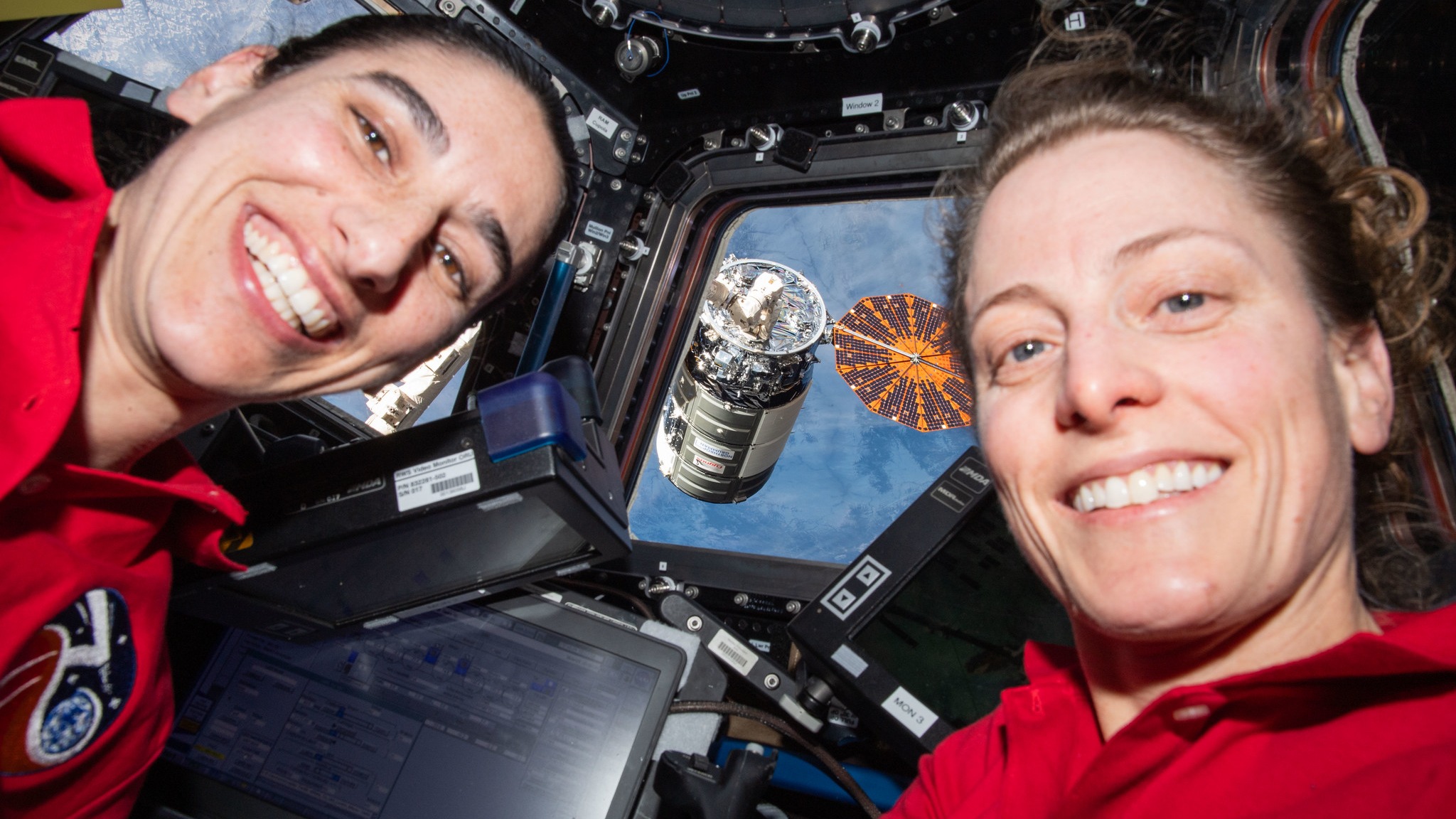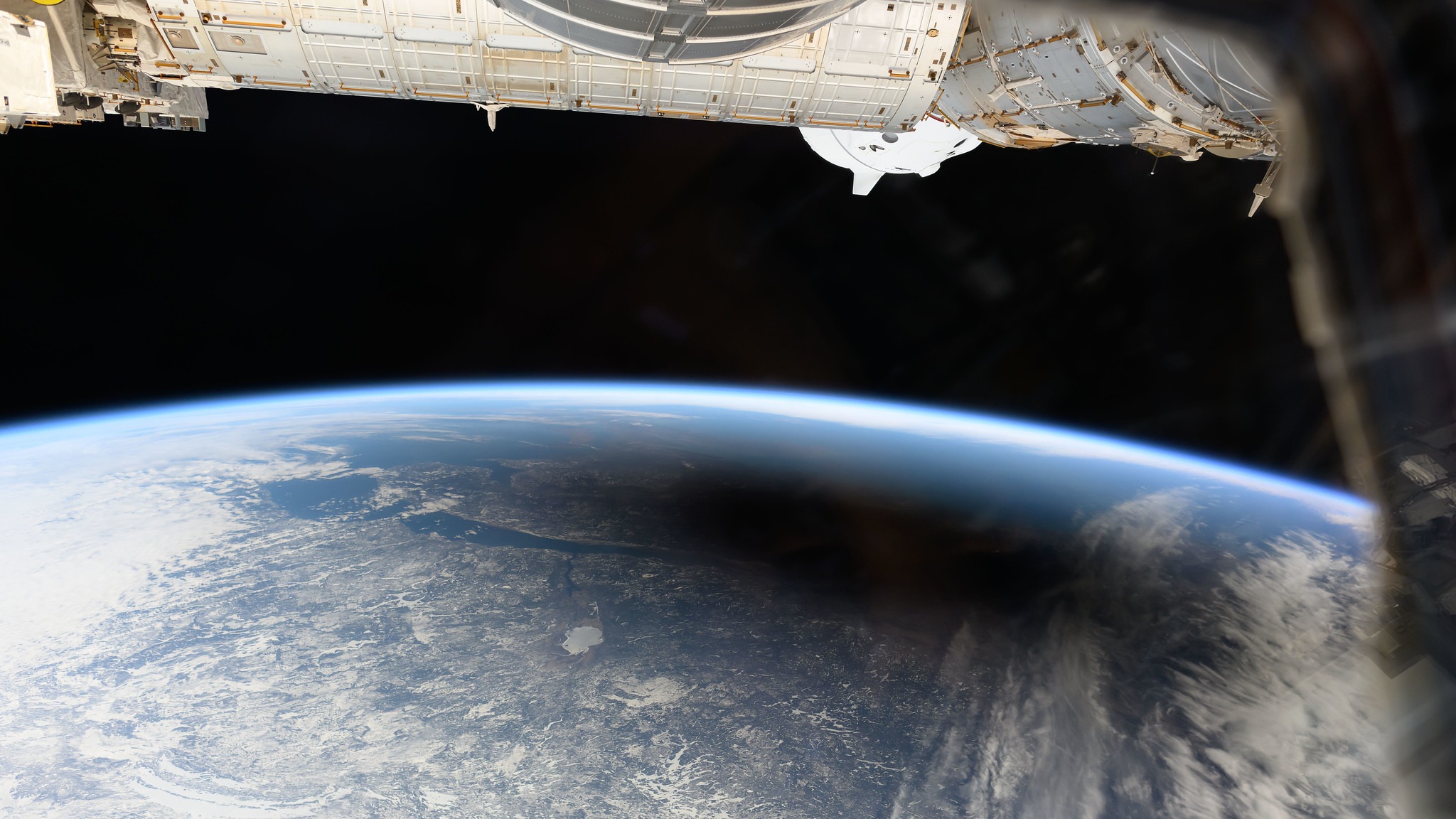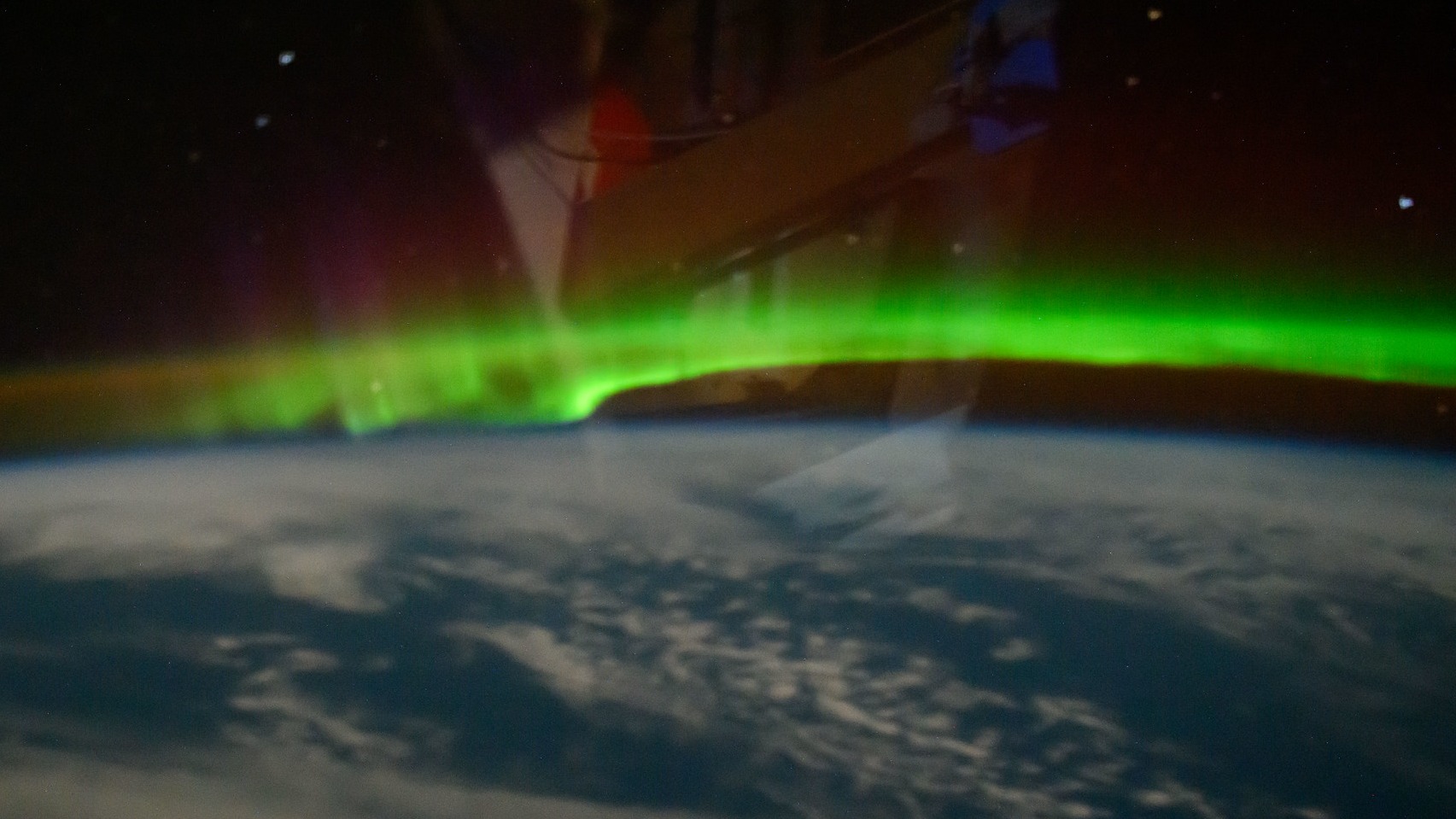NASA astronaut Loral O'Hara missed the total solar eclipse, but saw Earth 'moving' below her during spacewalk (photos)
"Nothing compares to the feeling of stepping outside, of being in your own little spacesuit looking at Earth, just through your helmet bubble."

NASA astronaut Loral O'Hara was prepared for her first spacewalk — but not for the view.
O'Hara, along with SpaceX Crew-7 NASA astronaut Jasmin Moghbeli, conducted the fourth all-woman spacewalk at the International Space Station (ISS) on Nov. 1, 2023. They spent 6 hours and 42 minutes performing station maintenance, such as replacing a bearing to keep the solar arrays moving.
All went well, O'Hara shared with reporters at NASA's Johnson Space Center in Houston, a success she attributed to hours of training with her spacewalking partner. And, she gushed, being inside a spacesuit was a moving experience.
"Nothing compares to the feeling of stepping outside, of being in your own little spacesuit looking at Earth, just through your helmet bubble," O'Hara told Space.com during livestreamed remarks today (April 15). "It's one thing when you're looking through the window, looking at Earth ... but then suddenly you're just immersed in the environment, and you're hanging there [with] the Earth moving below your feet."
Related: NASA astronauts complete 4th-ever all-female spacewalk outside International Space Station
NASA's Extravehicular Mobility Unit, or EMU, spacesuits were designed in the 1970s when the only humans flying to space were male. The spacesuits were thus made in a way that favors larger and stronger bodies, making it more difficult for women (or smaller bodies) to operate in the suit.
The newer generation of spacesuits (of which there are many designs, made by private contractors for the ISS and future Artemis program moon missions) will be more friendly for different body sizes. But, in the meantime, NASA accomplished its first all-female spacewalk with EMUs in October 2019 with Christina Koch and Jessica Meir, and aims to keep going.
Get the Space.com Newsletter
Breaking space news, the latest updates on rocket launches, skywatching events and more!
Related: Rare all-woman spacewalk this month won't be the last, NASA says

While O'Hara was one of the lucky few to see Earth through a spacesuit, she missed one rare planetary sight in space by just days: a total solar eclipse that passed over parts of the United States, Canada and Mexico on April 8 and was witnessed by space station astronauts as well.
Though back on Earth by then, O'Hara didn't see totality in person due to a slight delay in landing that pushed back her arrival to JSC from her landing zone in Kazakhstan. Initially she had planned on leaving Houston, under partial eclipse, to watch the totality show elsewhere. Instead, however, she stepped outside JSC to watch the partial eclipse in progress.

"I know they got a good show on space station," O'Hara said in response to a Space.com question, adding that she slightly regretted not seeing the eclipse. That said, the sun was evident in other ways during her tenure in space; auroras sparked by high solar activity were a regular sight.
"We got a lot of good auroras during our mission ... that was particularly beautiful, just watching space station kind of flying through the aurora was one of my favorite things."

O'Hara, a submersible engineer by training, had a call-back to her earlier days at sea while doing her newer job in space. One of her favorite moments, she said, was receiving a video from a friend's team doing a research cruise in the Pacific Ocean.
The friend "shared a video of a baby octopus hatching on the sea floor there," O'Hara recalled. Later that day, the NASA astronaut found herself flying over the very same water zone from which the video was taken.
"There's just this moment where I'm up in cupola," O'Hara said, referring to the wrap-around window used for ISS berthing and photography. "I'm in space, in this incredible space station that we built. And somewhere down underneath all that water is a baby octopus, going through its first few days of life.
"That's happening all over the planet in a million different ways," she continued. "It's just this recognition about how complex and diverse and beautiful Earth is, and all of the life that supports."
NASA and Russian federal space agency Roscosmos regularly fly astronauts on board each other's spacecraft for policy reasons; O'Hara's Soyuz spacecraft seat was part of a set of four announced by NASA in mid-2022. (NASA and Roscosmos also like to have a backup type of spacecraft available in case of a glitch.)
O'Hara launched and landed with different Russian-led crew, however, due to ISS staffing requirements. She went to space Sept. 15, 2023 with Roscosmos cosmonauts Oleg Kononenko and Nikolai Chub on board the Soyuz designated MS-24. O'Hara spent six months in space, but left before her Russian cosmonaut colleagues, who remain in space right now for a one-year mission.
O'Hara returned home on MS-24 on April 6, alongside Russian cosmonaut Oleg Novitskiy and spaceflight participant Marina Vasilevskaya (the first woman of Belarus to go to space.)
Novitskiy and Vasilevskaya's arrival back on Earth wrapped up their two-week mission that started March 23. They launched alongside NASA astronaut Tracy C. Dyson, who will spend six months in space, on Soyuz MS-25. The launch of Novitskiy, Vasilevskaya and Dyson was delayed two days due to a battery issue (swiftly resolved) that caused a rare launch pad abort on March 21.
Join our Space Forums to keep talking space on the latest missions, night sky and more! And if you have a news tip, correction or comment, let us know at: community@space.com.

Elizabeth Howell (she/her), Ph.D., was a staff writer in the spaceflight channel between 2022 and 2024 specializing in Canadian space news. She was contributing writer for Space.com for 10 years from 2012 to 2024. Elizabeth's reporting includes multiple exclusives with the White House, leading world coverage about a lost-and-found space tomato on the International Space Station, witnessing five human spaceflight launches on two continents, flying parabolic, working inside a spacesuit, and participating in a simulated Mars mission. Her latest book, "Why Am I Taller?" (ECW Press, 2022) is co-written with astronaut Dave Williams.
